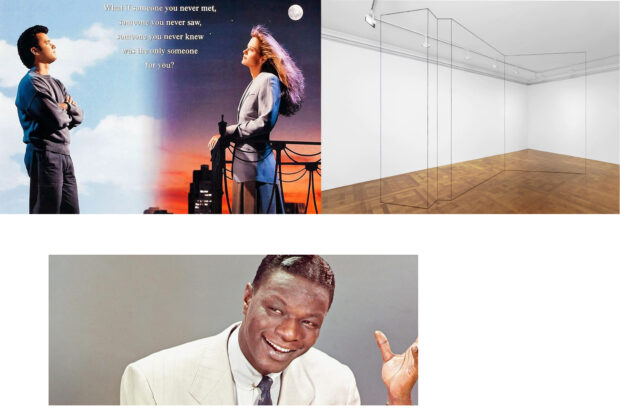The following is adapted from a longer presentation by Brett Lazer at the IFA In-House Symposium on January 22, 2010.
Learning from Las Vegas and the Antinomy of the Postmodern Manifesto
Along with Complexity and Contradiction in Architecture (1966), Learning from Las Vegas (1972) forms Robert Venturi and Denise Scott Brown’s classic articulation of a new path for architecture in the face of late Modernism. The basic assertion of the book is a turn towards the vernacular – not a vernacular of gables and dormers, nor Modernism’s industrial vernacular, but rather the commercial vernacular, with its apotheosis in the neon lights of the Las Vegas strip. Venturi and Scott Brown see the Modernist rejection of history, ornament, and denotative symbolism as irresponsible, empty, boring, and inappropriate. The expressionistic use of space and light that Modernism requires is incommensurate with the scale of American society, reformatted in recent years to the automobile and the highway. As Venturi puts it, “articulated architecture today is like a minuet in a discotheque.”[1] However, taking on Modernism is no easy task, requiring rhetorical contortions that call into question the very foundations of Venturi and Scott Brown’s project.
In Part I of Learning from Las Vegas, entitled “A Significance for A&P Parking Lots, or, Learning from Las Vegas,” Robert Venturi and Denise Scott Brown present the results of the Yale design studio that gave rise to their project.[2] Here, Venturi and Scott Brown return to a familiar trope in the title in order to cast themselves as consummate scholars. The two-word phrase – “learning from” – appears in the titles of several other works by Venturi and Scott Brown, including the articles “Learning from Lutyens,” “Learning from Pop,” and “Learning from Levittown.” Also to this end, Venturi and Scott Brown marshal a significant amount of “evidence” in support of their claims. The text is suspended in a substrate of images, which certain critics have interpreted as an attempt to “evoke the lived experience of the strip.”[3] But the illustrations are not merely pictures of buildings or billboards. Rather, the authors include a variety of maps that show demographics, activity patterns, and urban layout; and there are charts that trace concepts such as symbolism in urban space throughout history, and the difference between old and new monumentality. In this profusion of charts, graphs, tables, and maps there is pretense to scientific rigor – to a kind of a-theoretical empiricism.

Yet for all its scholarly posturing, Part I is actually rather thin. For example, discussing a chart that compares Versailles to the modern-day parking lot, Ritu Bhatt points out that, while suggestive, “the analogies drawn are completely ahistorical . . . It is in such analyses that the book starts to lose its potential for providing historical vision or methodological rigor.”[4] And indeed the charts and graphs, which amount to a series of empirical observations, are never transformed into true scholarship through critical analysis, meaningful synthesis, or interpretation. Rather, they seem to be included merely to connote scientific “objectivity” – they signify scholarly rigor without actually being used to make the text more scholarly or rigorous.

In Part II, “Ugly and Ordinary Architecture, or, The Decorated Shed,” Venturi and Scott Brown the Scholars transform into Venturi and Scott Brown the Activists. Indeed, throughout the book many of the ideas are encapsulated in catchy slogans and schemas. The “almost all right” phrases – “Main Street is almost all right” from Complexity and Contradiction and “Billboards are almost all right”[5] from Learning from Las Vegas; as well as the famous transformation of Mies’s “Less is More” into “Less is a Bore,”[6] – have come to be trademark sayings that sum up Venturi and Scott Brown’s ideas. Similarly, in Part II the authors create a shorthand for the stances of modern versus postmodern architects – “heroic and original” as opposed to “ugly and ordinary.”[7] Buildings are also divided into two classes, each with a nickname. A building “where the architectural systems of space, structure, and program are submerged and distorted by an overall symbolic form” is termed a “duck” and a building where ornament is applied independently of structure and program is called a “decorated shed”[8]. In all this Venturi and Scott Brown schematize the message of the book in a rhetorical manner such that it might have a more potent effect on those who read it.

Furthermore, the polemical aspect of the work is reinforced by the disjuncture between the first and second editions. The first edition was disavowed by Venturi and Scott Brown because of the “conflict between our critique of Bauhaus design and the latter-day Bauhaus design of the book”[9] but also because of its large size and $75 price tag. The second, pocket-sized edition, which the authors consider definitive, is, according to Aron Vinegar and Michael Golec, “more easily integrated into the reader’s life and integrated into conversations in the seminar room, the studio, even the café.”[10] That is, the revised edition, unlike the first printing, is able to fulfill its role of manifesto.
In Learning from Las Vegas, the writers’ dual identity as scholars and sloganeers is crucial to the work’s theoretical coherence.[11] Underlying some of Venturi and Scott Brown’s arguments in Learning from Las Vegas is a critique of the conception of the architect implied by Modernism – the architect as heroic form-giver, total designer. The authors assert that, “there is harm in imposing on the whole landscape heroic manifestations of the masters’ unique creations,”[12] and that, “total design conceives a messianic role for the architect as corrector of the mess of urban sprawl.”[13] This formulation runs expressly counter to Venturi and Scott Brown’s claim for the “incremental city that grows through the decisions of the many.”[14] Architects conceived according to Modernism are, apparently, “Experts with Ideals, who pay lip service to the social sciences[;] they build for Man rather than for the people . . .”[15]

This declaration, of course, does not reflect a balanced appraisal of the multifarious manifestations of Modernism, which range from experimental villas and worker housing in 1920s Europe to corporate skyscrapers in 1950s America. Rather, Modernism functions for Venturi and Scott Brown as a straw man that allows them to call for a radical change in architectural culture.[16] If unfair to a period of architecture that was anything but unified and consistent, Venturi and Scott Brown’s summary treatment of Modernism is necessary for it to stand up to the bombardment of their high polemics. To use Venturi and Scott Brown’s own phrase, in the context of Learning from Las Vegas, a nuanced understanding of modern architecture would be a “minuet in a discotheque.”
Yet it is that very discotheque – that is, Venturi and Scott Brown’s grand rhetoric – that necessitates the engagement of multiple discursive stances. Venturi and Scott Brown’s slogans, and their pronouncements that, for example, “this is not the time and ours is not the environment for heroic communication through pure architecture,”[17] inevitably recall other rhetorical slogans and grand pronouncements such as, “The house is a machine for living in,”[18] or, “Modern life demands, and is waiting for, a new kind of plan, both for the house, and for the city.”[19] These latter slogans and pronouncements, however, hail from Le Corbusier’s Vers une Architecture, the Modernist counterpoint of Learning from Las Vegas, and the very expression of that against which Venturi and Scott Brown are writing. Though, unlike the Modernists, Venturi and Scott Brown do not advocate a specific formal language, they call in high rhetorical fashion for the widespread adoption of their own given approach to solving the problems of space, structure, program, and symbolic expression. As far as urban planning, though they are against a total design solution of heroic-form megastructures, Venturi and Scott Brown’s touted heterogeneity is still prescriptive. In short, their derision is thinly veiled when referring to “Experts with Ideals . . . who build for Man.” Yet what are Venturi and Scott Brown but other experts with ideals, who believe their design philosophy promotes the betterment of mankind in creating a more appropriate, responsible architecture?
It is at this point that Venturi and Scott Brown the scholars save the day. The more empirical and “objective” stance evoked in Part I undercuts the high polemics of the text following. It dissembles the fact that to combat the totalizing rhetoric of Modernism, to engage it on its own terms, Venturi and Scott Brown must themselves use such totalizing rhetoric. Thus Learning from Las Vegas is, at its core, a manifesto, but one enshrouded in history – a polemic with the patina of purely objective observation. The charts and graphs are the scrims of the theater in which Learning from Las Vegas is played – ornament on the shed of polemic.

Turning to an example of Robert Venturi’s early built work, we see a tendency towards a similar kind of performance. Guild House, a home for the elderly, was built in 1963 in Philadelphia, and though unremarkable at first, its conception involves a series of complexities that mirror the rhetorical double-talk of Learning from Las Vegas, none more important than that signaled by the material that constitutes the façade. In Learning from Las Vegas we are told that “[t]he material is common brick – darker than usual to match the smog-smudged brick of the neighborhood.”[20] In trying to mimic the coloration of the surrounding buildings, Venturi attempts to fit Guild House within its context. But rather than build the façade out of regular brick, which would eventually weather as it had on the neighboring buildings, Venturi used a specially-colored brick, so that the building would instantly fit in. It is ironic that Venturi’s attempt to make the building seem normal in fact prevented it from being normal. Thus, for all its pretensions to banality, Guild House is really a complex, ironic, “architect’s architecture” – carefully designed, using specialty materials, but masquerading as a simple Philadelphia row house.
So, both the text and the building involve an element of dissimulation, but why all the subterfuge? One explanation is that this is part of the Pop strategy that Venturi and Scott Brown have long been interpreted as employing. As the architects have gone to great lengths to emphasize, they “are part of a high art, not a folk or popular art tradition.” Despite their posturing, they have no interest in designing buildings that are straightforward and everyday, and no desire to produce disinterested scholarship. Does this antinomy negate the authors’ push for a non-heroic architecture? Or does it merely suggest the irreconcilable nature of the rift between the rarefied role of the architect posed by Modernism and the decidedly un-rarefied dynamics of the actual growth of the built environment? Given Venturi and Scott Brown’s embrace of complexity and contradiction, perhaps that is the point.
Brett Lazer is a PhD candidate at the Institute of Fine Arts, focusing on 16th and 17th century Spanish and Latin American Colonial art.
1. Robert Venturi, Denise Scott Brown, and Steven Izenour, Learning from Las Vegas: The Forgotten Symbolism of Architectural Form, Revised Edition (Cambridge, MA and London: MIT Press, 1977), 139.
2. As a project, Learning from Las Vegas went through several incarnations spanning nearly a decade. It began in the spring of 1968 with an article in Architectural Forum entitled “A Significance for A&P Parking Lots, or, Learning from Las Vegas.” In the fall of that year, Venturi and Scott Brown ran a design studio at Yale called “Learning from Las Vegas, or Form Analysis as Design Research.” The book was published in 1972 by MIT Press and the revised edition came out in 1977.
3. Ritu Bhatt, “Aesthetic or Anaesthetic: A Nelson Goodman Reading of the Las Vegas Strip,” in Relearning from Las Vegas, eds. Aron Vinegar and Michael Golec (Minneapolis and London: University of Minnesota Press, 2009), 19-30.
4. Ibid., 27.
5. Venturi, Scott Brown, and Izenour, 6.
6. Robert Venturi, Complexity and Contradiction in Architecture (New York: Doubleday, 1966), 25.
7. Venturi, Scott Brown, and Izenour, 93.
8. Ibid., 87.
9. Aron Vinegar and Michael Golec, “Introduction” in Relearning from Las Vegas, eds. Aron Vinegar and Michael Golec (Minneapolis and London: University of Minnesota Press, 2009), 1-17.
10. Ibid., 7.
11. This double identity is not wholly foreign to Venturi’s work. In Complexity and Contradiction in Architecture, his so-called “gentle manifesto” of 1966, Venturi opens with a subjective statement of principles: “I am for richness of meaning rather than clarity of meaning; for the implicit function as well as the explicit function. . .” (Venturi, 1966) Then, over the following pages, such statements fade into a series of close visual analyses. Pictures of Gothic cathedrals, Shingle Style houses, Mannerist façades, and even early Corbusier serve to illustrate the point, complementing the text in a manner reminiscent of an art historian’s slide lecture.
12. Venturi, Scott Brown, and Izenour, 148.
13. Ibid., 149.
14. Ibid.
15. Ibid., 154.
16. They acknowledge as much in a passage squirreled away in the preface to the first edition of Learning from Las Vegas, in which they assert, “Our argument lies mainly with the irrelevant and distorted prolongation of that old [Modernist] revolution today.” (Venturi, Scott Brown, and Izenour, xiii) However, this line is all but forgotten in the tidal wave of Venturi and Scott Brown’s billboard slogans.
17. Venturi, Scott Brown, and Izenour, 163.
18. Le Corbusier, Towards a New Architecture, trans. Frederick Etchells (New York: Dover Publications, 1986), 4.
19. Ibid., 3.
20. Venturi, Scott Brown, and Izenour, 91.









[…] inaugural edition of the IFA-CAC blog. Please check out Kristen Gaylord on Sergej Jensen at PS1, Brett Lazer on Robert Venturi and Denise Scott Brown’s Learning from Las Vegas, Bobby Brennan on Christian Marclay’s The Clock at Paula Cooper, and Rae Kaplan on Esteban […]
[…] from Learning from Las Vegas showing casinos, from the Contemporary Art Consortium @ the IFA website (not featured in 100 […]